
ACT Science Practice Test 45
Đề thi nằm trong bộ sưu tập: Tuyển Tập Bộ Đề Thi Đại Học Hoa Kỳ (ACT) - Có Đáp Án Chi Tiết
Số câu hỏi: 22 câuSố mã đề: 1 đềThời gian: 1 giờ
217,098 lượt xem 16,696 lượt làm bài
Xem trước nội dung:
Engineers studied the trajectories of a cannonball launched from a cannon under various conditions.
Study 1
On a level surface during a mild day, engineers launched a cannonball from a cannon as shown in Figure 1.

Figure 1
A camera was fixed atop the cannon so that it would point in the direction of the cannonball's launch. A receiver was also fixed to the cannon to record the cannonball's position as recorded by the camera.
As the cannonball traveled through the air, angle θ, which is defined in Figure 1, consistently changed. The change in θ was captured by the camera every 0.25 seconds after launch until the cannonball landed. For each recorded image, θ was measured (Figure 2).

Figure 2
Furthermore, every 0.25 sec after launch, the receiver sent out a radar pulse, part of which was reflected by the cannonball to the receiver. The roundtrip travel time of each pulse was recorded to determine the distance, d, between the receiver and the ball at any given time (see Figure 3).
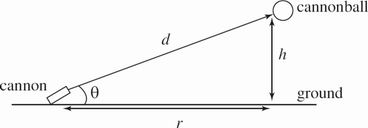
Figure 3
Using d and θ, the engineers determined the ball's height, h, and distance, r, at the end of each 0.25 sec interval. A curve plotting h versus r was constructed.
This procedure was followed using cannonball launch starting speeds of 135 ft/sec, 150 ft/sec, and 180 ft/sec. For each launch speed, the ball was launched at θ = 30°. The curves representing h and r for each of the launch speeds were connected by lines for time, t = 2 sec, 3 sec, 4 sec, and 5 sec after launch (see Figure 4).
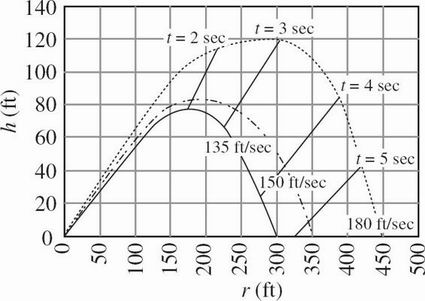
Figure 4
Study 2
Using an algorithm, the engineers calculated h and r at 0.25 sec intervals for the same cannonball launched in a vacuum in otherwise similar conditions to those in Study 1. The results are plotted in Figure 5.
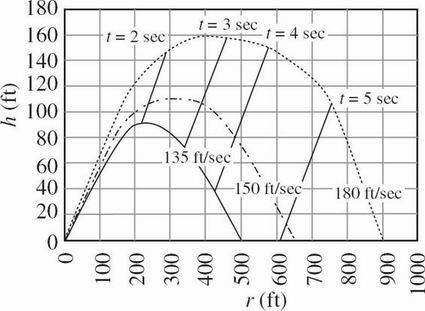
Figure 5
Suppose the cannonball were launched at 30° in a vacuum from a height of 5 ft. Based on Figure 5, the cannonball would land approximately how many feet farther from the cannon if it were launched at 150 ft/sec than if it were launched at 135 ft/sec?
50 ft
150 ft
500 ft
650 ft
While the cannonball was in flight, how often did the camera record the position of the ball?
Once per second
Twice per second
Three times per second
Four times per second
The cannon was an instrumental weapon used during the Ottoman invasion of the city of Constantinople in 1453. Assume that cannonballs identical to those used in Study 1 were launched on a windless day with a starting height of 5 ft above the ground and an angle of θ = 30°. If the launch speed of each cannonball were 180 ft/sec, how close would the cannon have needed to be to the 40-ft-tall wall surrounding Constantinople in order to travel over it?
425 ft
575 ft
700 ft
850 ft
Based on Figure 4, as the initial speed of the launched cannonball was increased, how did the values of h and r change at t = 4 sec?
_h__r_
decreased decreased
decreased increased
increased decreased
increased increased
Based on Figure 5, if the ball were launched in a vacuum from a height of 5 ft at 135 ft/sec and θ = 30°, how long would the cannonball most likely be in flight from launch to landing?
Between 4 sec and 5 sec
Between 5 sec and 6 sec
Between 6 sec and 7 sec
Between 7 sec and 8 sec
Based on Figure 3, if c represents the speed of light, which of the following represents the time taken by each radar pulse to make the roundtrip between the receiver and the ball?
2cd
2dc
The apoptotic index (AI) for a group of dividing cells is calculated as follows:

Figure 1 shows the AI for a culture of fibroblast cells as a function of the surrounding concentration in parts per million (ppm) of a cell toxin.
*
Figure 1
One thousand actively dividing fibroblast cells in culture were studied. Figure 2 shows the distribution of the cells in each of the stages of the dividing cell cycle.

Figure 2
Electron micrographs were taken of the fibroblasts in culture. Figure 3 shows an example of cells in each of the 4 stages of the dividing cell cycle. Although the cells are not arranged in the sequence of the cell cycle, each stage is shown only once.
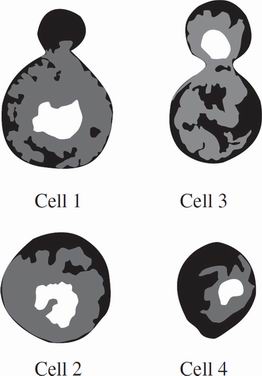
Figure 3
Which cell in Figure 3 is most likely in the stage of the cell cycle during which cytokinesis is occurring as mitosis nears completion?
Cell 1
Cell 2
Cell 3
Cell 4
Based on Figure 1, of the fibroblast cells that are surrounded by a toxin concentration of 90 ppm, the percent that are in apoptosis most likely is represented by which of the following ranges?
Less than 0.5%
Between 0.5% and 0.6%
Between 0.6% and 0.7%
Greater than 0.7%
Which of the following cells in Figure 3 is most likely in the first stage of the actively dividing cell cycle?
Cell 1
Cell 2
Cell 3
Cell 4
According to Figure 2, how did the number of fibroblast cells in stage G2 compare with the number of cells in stage S? The number in G2 was approximately:
2 times as great as the number in
3 times as great as the number in


Based on Figure 2, of the fibroblast cells that were in the actively dividing cell cycle, the proportion that were in G1 is closest to which of the following?




A polymorphism is the persistent occurrence of different appearances for a particular trait in a species. All humans have slight differences in their genotypes (genetic code) that result in different phenotypes (observable characteristics). Genetic polymorphisms are persistent variations in gene sequences at a particular location in chromosomes, such as those accounting for different blood types. Variations that cannot be observed with the naked eye require techniques such as capillary electrophoresis (the separation of genetic or protein material based on charge characteristics using an electric field).
The label on a vial of blood from a hospital patient was lost. The sample just tested positive for a disease of the blood protein hemoglobin that is very common in the hospital population. The sample was traced to a room with 4 patients who were subsequently tested to determine the source of the initial vial.
Tests and Results
Smears of the blood from the unidentified patient (P) and from the 4 newly tested patients (1–4) were observed under the microscope for the appearance of the blood cells. Results are shown in Table 1.
Table 1
Patient Blood smear findings
P Sickle cells
1 Target cells
2 Sickle cells
3 Normal blood cells
4 Sickle cells
Serum was isolated from the blood of Patient P and from Patients 1–4 and placed in separate tubes. A buffer was added to each vial to establish a pH of 8.6. One at a time, samples from each tube were injected into the capillary electrophoresis device set at 7.5 kilovolts (kV) to separate the types of hemoglobin present into peaks. The hemoglobin proteins composing a peak had similar charge characteristics. Figure 1 shows the peaks that resulted from all 5 samples.
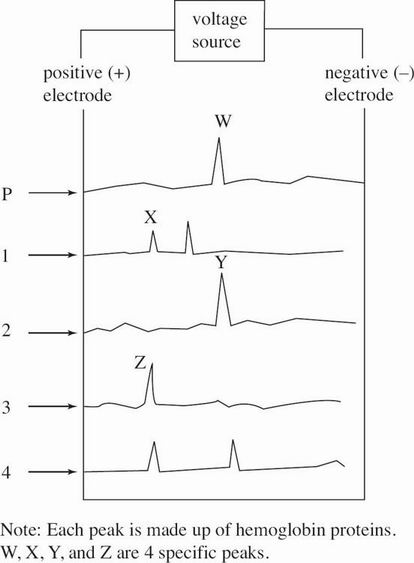
Figure 1
Are the data in Table 1 consistent with the hypothesis that Patient 4 and Patient P are the same person?
Yes; Patient 4 has the same blood cell appearance as Patient
Yes; Patient 4 has different blood cell appearance as Patient
No; Patient 4 has the same blood cell appearance as Patient
No; Patient 4 has different blood cell appearance as Patient
What is the most likely reason that the serum samples were treated with a buffer to bring pH to 8.6 ?
Hemoglobin protein breaks down at that p
All bacteria and viruses are destroyed at that p
Capillary electrophoresis separation of hemoglobin functions best at that p
Capillary electrophoresis separation of hemoglobin does not function at that p
Sickle cell anemia is caused by certain hemoglobin genotype combinations of 3 different alleles. The HbA allele is responsible for normal hemoglobin, the HbS allele is responsible for one variant that results in sickle cells, and the HbC allele is responsible for a different variant also resulting in sickle cells. Based on Table 1, the genotype of Patient 4 could be which of the following?
I. HbAHbA
II. HbAHbS
III. HbAHbC
II only
I or III only
II or III only
I, II, or III
According to Figure 1, the pattern of protein peaks produced by serum from Patient P most closely resembles the pattern produced by the serum sample from:
Patient 1.
Patient 2.
Patient 3.
Patient 4.
Based on Figure 1, the hemoglobin proteins in which of the following 2 peaks were most likely closest in charge characteristic?
W and X
W and Z
X and Y
X and Z
During the capillary electrophoresis, all the hemoglobin proteins started with some quantity of charge before migrating from left to right in Figure 1. Therefore, the proteins resulting in peaks furthest to the left must have been the most:
negative, as opposite charges attract each other.
negative, as opposite charges repel each other.
positive, as opposite charges attract each other.
positive, as opposite charges repel each other.
To help design a carnival game, bowling balls at rest on the ground are launched along a track by a constant force spring apparatus as shown in Figure 1.

Figure 1
To win the game, the ball must pass Point Y but not Point Z. A total of 5 trials were done to determine the best design. For each combination of ball friction coefficient, μ, and ramp angle, θ, Point W was put at a distance, d, from Point X such that the ball will just barely reach Point Z before rolling back toward the ramp.
The ball's kinetic energy (KE) at Points X and Y along with its potential energy (PE) at Point Y are shown in joules (J) in Table 1 for each trial. The mechanical energy (ME) of the ball at any given point is the sum of its kinetic and potential energies. It should remain constant provided no energy is lost in the form of heat from friction or drag forces.
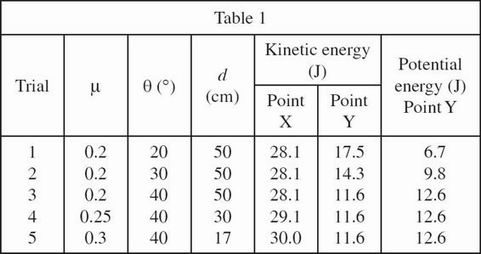
Which of the following ranks Points X, Y, and Z from where the bowling ball had the slowest velocity to where the bowling ball had the fastest velocity during any trial?
Point X, Point Y, Point Z
Point X, Point Z, Point Y
Point Z, Point X, Point Y
Point Z, Point Y, Point X
In Trial 4, at the point immediately before climbing the ramp, the bowling ball's ME was closest to which of the following?
0 J
11.6 J
24.2 J
29.1 J
Based on the results of Trials 1–3, if an additional trial is performed with μ = 0.2 and θ = 50°, PE at Point Y will most likely be:
greater than 12.6
between 9.8 J and 12.6
between 6.7 J and 9.8
less than 6.7
The results of Trials 3–5 indicate that as the coefficient of friction increases, the minimum distance of Point W from Point X required for the bowling ball to barely reach Point Z:
only increases.
only decreases.
remains the same.
varies, but with no general trend.
The law of conservation of energy states that the total amount of energy in an isolated system remains constant. In which of the trials, if any, was mechanical energy transformed to heat energy?
Only Trial 1
Only Trial 5
All trials had mechanical to heat energy transfers.
No trials had mechanical to heat energy transfers.
